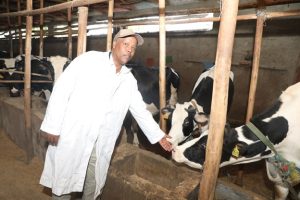
Sunflower is one of the most important oilseeds in Ethiopia. The country has enormous potential for its production. Sunflower is widely adaptable with high yield than major oilseeds in the country. Recently, some private farmers have started growing it to meet the high demand for it. It is an input for oil production and this encouraged the farmers to increase production through time. The country is endowed with large agricultural land suitable for sunflower production. In Ethiopia, research on sunflower was started late with the growing interest from private sector to produce sunflower. Studies show that sunflower was introduced to Ethiopia over a century ago. Cultivated sunflower can be grouped into categories based on its use and these are oil extraction and ornament for confectionary.
The sunflower oil has health benefits with great acceptance from consumers. It is considered best oil for salad, cooking and margarine production. Its seeds are used as snacks and feeds for birds and small animals. Sunflower types differ by oil content and seed size. Oil seeds are relatively small and black with low body structure and high oil content while confectionary seeds are large in size, which are usually black with white stripes, with lower oil content and large in size. The last variety includes those grown for ornamental purpose. These are used in gardens, home landscape or as flowers. Sunflower has high oil content and productivity as indicated by B. Mengistu and M. Tesfaye.
In Ethiopia, the other major oilseeds which are currently used by the oil millers are linseed, mustard and cotton. Although linseeds are dominantly used for edible oil, their productivity and oil content is lower than sunflower. The oil from sunflower, however, is finest due to its light color, flavor and good nutritional quality. Moreover, it has high yield as it is suitable for cultivation. With these advantages, it has high demand by processing firms. Although sunflower is not widely grown in Ethiopia, the country has potential for sunflower production. Warm areas with altitude of 1400-2400 meters above sea level and with well drained clay/sandy soil are suitable for it. Farms that produce maize used to grow sunflower as one of the crops planted in rotation. The early maturing variety is recommended for wide-scale production, as it is relatively adaptable.
It is reported that sunflower production is increased in the last decades with slight increase in the size of land reserved for it. Despite small area of land used for its production, its productivity is high. Sunflower can be grown in a wide range of agro-ecology in Ethiopia. Currently, the crop is grown with lesser attention to it. Studies show that adaption trials indicated that the crop performed best in warmer areas where other major crops fail to grow. There are districts that have great potential for large scale production of sunflower in Ethiopia. Sunflower improvement started a few decades ago when only three varieties namely Russian black, Hesa and Pop-158 were recommended for production at national level.
There are varieties that are late maturing, tall and less uniform, which require systematic research. Based on research findings, sunflower varieties with desirable agronomic traits are yet to be released to promote production. A few decades later, quick and shorter varieties that required lower rainfall and warmer areas have been developed by researchers. Reports show that none of these varieties are released and the farmers also lost interest in producing the crop on time. Moreover, the crop faced severe damage caused by birds in the production area. It is also susceptible to plant diseases that have not yet been researched and addressed properly. These are major challenges that need further studies on the production of the crop.
Due to past challenges, the research centers slowed the program and all the research materials have been partly used. In Ethiopia, research on sunflower has, therefore, been partly conducted. Since the last few years, however, it seems that there is a growing interest from the private sector to produce sunflower. Following this, research centers have, therefore, started to revive full-fledged studies on sunflower. Some of the research outcomes have been discussed by researchers. The first variety of sunflower seeds is obtained from abroad for adaption trial at research centers. These varieties have shown relatively better uniformity, early maturity and shorter height.
Some of the varieties have not yet been nationally registered as the adaption trial is conducted in limited locations. Also, it is not possible to find the history of the variety from the country of origin. It is, however, possible to develop the first pollinated sunflower variety from research centers. In order to exploit the existing variety of sunflower for improvement, the oilseeds research has to be conducted along with the existing varieties maintained for breeding. Most of the sources from which varieties are accessed are the different regions of Ethiopia. Characterization of sunflower seeds is made with standard checks. The experiment is done with simple design for planting sunflower seeds in rows with certain lengths. Each design is evaluated with major traits such as date of flowering and maturity, plant height, stem diameter and yield per plot. The value of each trait is analyzed and its output is measured.
According to analysis of variance, the date of maturity, plant height and stem diameter of some sunflower seeds are found to be better in yield. From the breeding point of view, plants having short maturity regime, shorter to medium height, uniform and single head are preferred. They could be sources of early maturing varieties suitable for harvesting at one interval. A sample of sunflower is found to be early maturing with short height while others are less productive. A number of other hybrid sunflower varieties have been registered through conducting adaptation trial at various locations in collaboration with different farmers. The adaption trials have been conducted at different research centers.
Several hybrid sunflower varieties are registered in Ethiopia. These varieties are found to be adaptable to wide agro-ecological zones. They have high productivity with better oil content. The hybrid varieties are uniform in maturity, shorter in height and usually single headed as compared to other local varieties. They are also suitable for mechanized farming. As the cost of the seed is exorbitant small farmers find it hard to produce it. It is, therefore, necessary to develop new low cost sunflower varieties which should be early maturing, uniform and productive in terms of seed yield and oil content. In this regard, research is being undertaken to identify more productive sunflower varieties.
The breeding work has been started with the objective of enhancing productivity using selected sunflower seeds. Selection started with big head size, shorter and moderate height, having less number of branches. These are evaluated under different circumstances and field conditions to protect contamination from bees and other flies. The cycle of selection is made until uniform and productive sunflower sample is obtained. The selected variety is promoted to national variety trial. The promising variety with better seed yield, uniform, high oil content with desirable agronomic performance and disease resistance will be released for production at the national level.
Limited agronomic and crop protection research has been conducted in sunflower in specific locations. The researchers have made recommendations based on studies in selected areas. They recommend planting sunflower in June at a given spacing that resulted in a higher seed yield. They pointed out that fertilizer application does not have significant effect on sunflower yield. Assessments on yield losses from weed indicated that weeding on the third week after plant emergence is enough to reduce full season weed effect. This reduces yield loss to economically negligible level. This experiment is carried out at different locations for successive years to study the fertilizer requirement of sunflower varieties at the study locations. Research based application of fertilizer rate per hectare may be recommended for sunflower varieties.
In Ethiopia, fungus, blight, decay and rust and leaf spot are identified as diseases of sunflower. Higher incidence of fungus is noted with excessive delays in sowing dates. The disease can be controlled by spraying the seeds of sunflower with chemicals. Unless prevented the disease causes tremendous yield losses as noted in the farms. With limited research on the sunflower diseases, farmers face tremendous crop losses. Surveys made in the sunflower growing parts of the country enabled to identify several species of insect pests on sunflower. Traditionally, “crop rotations” with sufficiently long enough periods are perceived to be better preventive measure.
Studies indicate that sunflower production area coverage is very small in Ethiopia and the popularization of the crop is rare. However, farmers have a growing interest in the crop and private firms are increasing their demand for it to produce oil. Also, consumers have preference for sunflower oil despite its high market price. All these indicate that local production of sunflower will be profitable. As an export item, it saves foreign currency through import substitution. Moreover, there is a possibility to grow confectionary sunflower seed for food. Its stems and leaves can be used for fuel. Despite its diverse uses, sunflower production and marketing are very limited. It is obvious that the improvement of sunflower should proceed in line with market demand for it.
The introduction of the selected variety of sunflower, its hybridization and promotion are necessary measures for the economic benefit of Ethiopia. The current effort of developing high yielding varieties should be strengthened with improved quality oil content of sunflower. In the near future the sunflower seeds are designed to develop hybrid varieties. The use of modern tools of plant breeding should be in place with all the necessary conditions, including trained staff and facilities provided for further research. The sunflower production should be targeted for export markets. The concerned agricultural agencies should, therefore, provide all the necessary inputs for farmers and firms engaged in the production of the crop.
BY GETACHEW MINAS
The Ethiopian Herald 12 August 2021




